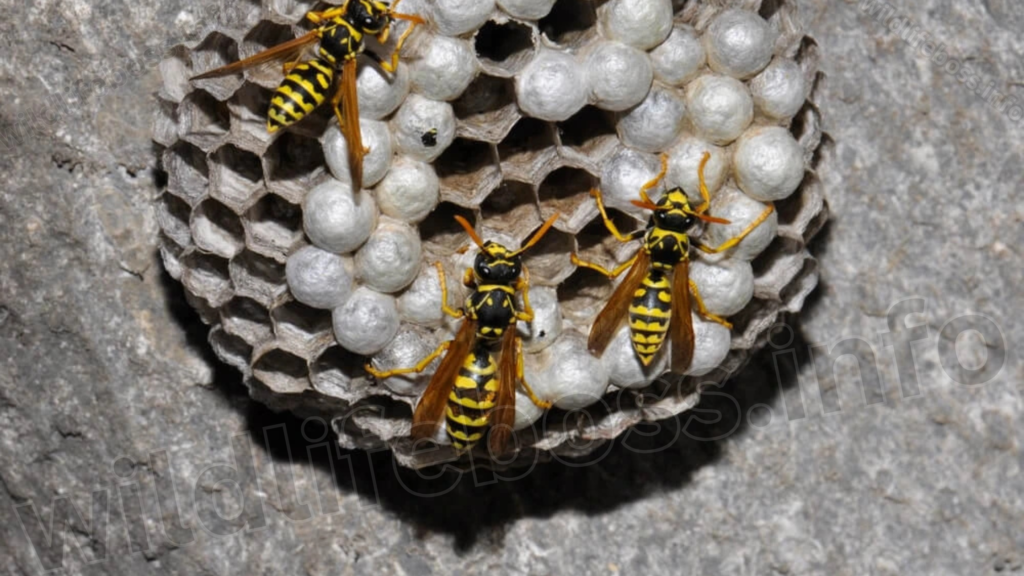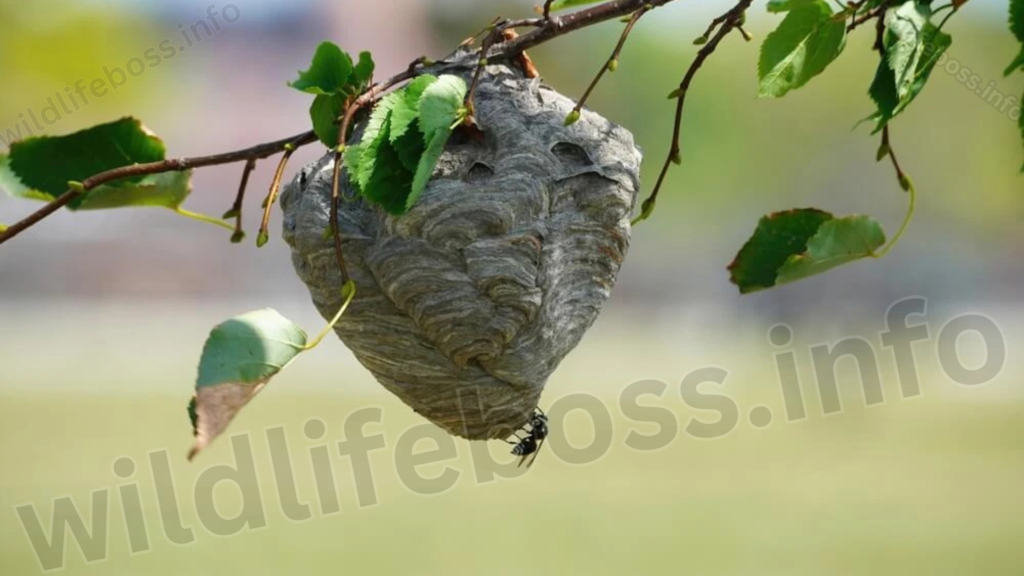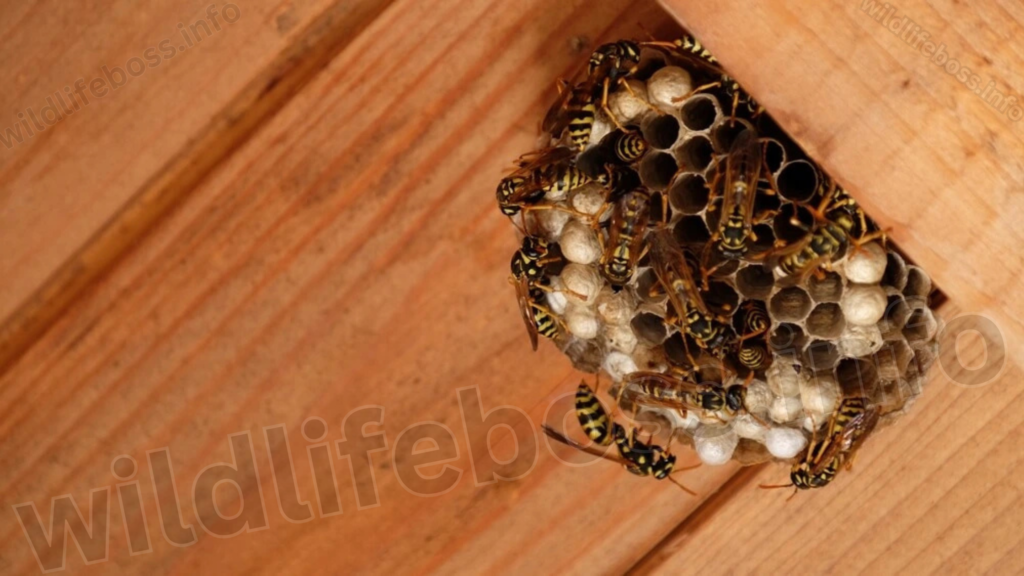Among the 18,000 wasp species found in North America are hornets, paper wasps, mud daubers, and yellow jackets.
Correct identification and management of the species can be facilitated by understanding the appearance of their nests and how they differ from one another.
Hornets construct nests with a single entrance that are globular or egg-shaped. The outside has a texture similar to paper and is light gray. Although their nests are similar, yellow jacket wasps’ nests are irregularly shaped and feature several entrances. Mud daubers and paper wasps have tiny nests that resemble mud pipes or an upside-down paper parasol, respectively.
The following table provides a brief comparison of Hornet Vs Wasp Nest:
| Characteristics | Hornet Nest | Paper Wasp Nest | Yellow Jacket Nest | Mud Dauber Nest |
|---|---|---|---|---|
| Appearance | Globular or egg-shaped | Similar to an inverted umbrella | Irregular shape | Tubular |
| Exterior | Paper-like | Paper-like | Paper-like | Muddy |
| Nest size | Around 30 inches in circumference | 3 to 10 inches wide | Up to several feet wide | Up to 8 inches wide |
| Colony size | Up to 700 hornets | Up to 100 wasps | Thousands of wasps | One adult/up to 20 young per nest |
| Color | Gray | Gray, grayish-green, or straw | Gray | Grayish brown |
| Interior structure | Hexagonal cells | Hexagonal cells | Hexagonal cells | Tubular chambers |
| Typical location | Trees, large bushes, ceilings, walls | Walls, ceilings, and other sheltered areas around homes | Sheltered spots above the ground | Urban structures or other sheltered spots above the ground |
*Magazines and newspapers, educational websites, pest control experts, governmental organizations, and other official sources referenced throughout the text provided all of the data.
7 Key Differences Between Hornet Vs Wasp Nests:
1. Appearance
The form is the primary distinction between hornet vs wasp nests. To assist you in identifying them, here are the various kinds of nests.
Hornet Nests
The nests of hornets are always somewhat spherical. Depending on the location and size of the colony, their actual shape might range from globular to egg-shaped.
Although nests that are “glued” to a vertical wall without any top support are also common, the upper side is usually fastened to a tree branch or roof.
Even though hornets can live in vast colonies with up to 700 individuals, all hornet nests have in common that they only have one entrance.
Paper Wasp Nests
Paper wasps build strange-looking nests that look like an umbrella turned upside down.
From below, these nests resemble honeycombs because they are made up of several hexagonal compartments. A narrow stem connects the top to a ceiling or branch. As an alternative, the nest can be fastened to a wall that is vertical.
One of the main differences between hornet vs wasp nests is that the latter have uncovered exterior cells instead of an outer barrier.
Mud Dauber Nests
Mud daubers exploit any protected area beneath or above ground. Since above-ground nests are essentially composed of mud, they can take on any shape, from tube to mud pile.
Depending on the number of occupants and the purpose of the nest, these nests may have one or several openings.
Although they are solitary, female mud daubers can lay up to 20 eggs in a single nest. This nest is first shared by wasp larvae and their young, and they may chew out other entrances.
A multi-entranced mud dauber nest, however, is usually abandoned.
Yellow Jacket Nests
Although they are not always circular, yellow jacket nests may resemble hornet nests. The size of these wasps’ nests can range from a few inches to several feet, and they reside in vast colonies.
The nest typically has several entrances, and the chambers are shielded by outer walls that resemble paper.
2. Exterior Texture
The appearance of hornet vs wasp nests and yellow jacket, paper wasp nests is similar to that of paper, and for good cause.
The wood fibers that the aforementioned species chew up and then spit and bond with saliva are used to construct their nests.
Wasps and hornets soften the wood pulp by chewing it, turning it into a substance that resembles paper.
Since these insects construct their nests out of mud, mud dauber nests are a different tale. Therefore, although tiny nests may resemble mud tubes or pipelines, they appear to be mud mounds.
3. Size

Paper wasps and mud daubers have the smallest nests of any wasp on this list.
Mud daubers are wasps that live alone. Adults frequently exploit crevices or gaps in walls or roofs, therefore they may or may not reside in nests.
For their young, female mud daubers usually construct nests that range in size from a few inches to roughly the size of a fist.
Depending on the size of the colony, paper wasp nests can range in size from three to ten inches, making them comparatively modest.
Hornet and yellow jacket nests are bigger. While the latter can be many feet in length or circumference, and some are even as enormous as a car, the former are usually about the size of a basketball.
Sea Also: 16 Best Insect Species That Are Similar to Butterflies(With Photos)
4. Color
Yellow jackets and hornet vs wasp nests all use the same color and a materials that resembles paper to build their nests.
The typical color of these nests is light gray, though paper wasp nests may contain a tinge of pale yellow or grayish green.
The only nests that vary in color just by virtue of their diverse composition are mud dauber nests. These nests are a grayish-brown tint that resembles dried mud.
5. Interior Structure

Mud daubers are once again the only wasp species that stand out in terms of the inner structure.
Hexagonal cells make up the compartmented interior of hornets, yellow jackets, and paper wasp nests.
They resemble honeycombs when viewed from the inside, with the main distinction being that honey is not present.
The size of the colony has a significant impact on the number of cells. For example, the number of cells in hornet nests can range from 1,500 to 3,000. In a similar vein, yellow jacket nests may include 500–15,000 cells.
Nests of paper wasps typically contain 200 cells. The smallest in this regard are mud dauber nests, which have a maximum of 25 cells. The tubular shape of these cells resembles the pipes of a church organ, and each pipe is further divided by mud.
In each cell, mud dauber females capture multiple spiders and imprison them within, rendering them immobile. In each cell, they then deposit an egg.
Shortly after hatching, each mud dauber larva begins eating the paralyzed spiders; after finishing the development of their digestive tract, they expel a waste sac in a section of the pipe.
Before becoming adults the next spring, the larvae hibernate in the nest and seal off the area where the waste sac is kept with mud.
6. Colony Size
Each nest’s size and cell count provide a clear indication of the size of each species’ colony. The smallest colonies are usually mud daubers, with up to 20 to 25 young.
Once the eggs are laid, the solitary adult mud daubers leave the nest. Although they occasionally construct little nests for themselves, they often seek refuge in the crevices and openings in urban buildings’ walls and roofs.
Next are paper wasps, which can have between 20 to 30 adults and colonies of up to 100 individuals.
The huge hornet vs wasp nests and yellow jackets can house hundreds or even thousands of individuals, making them highly gregarious wasps.
A colony of European hornets typically consists of 500 wasps, while larger nests with 700 or more wesp are also typical.
Up to 5,000 people can live in yellow jacket colonies, including young people and adults who do not work.
7. Typical Location

Observing the nest’s placement is another method of determining the type.
Nests of European and Bald Faced Hornets are always constructed above ground, typically at a height of three feet or more. The preferred habitats of bald-faced hornets are open spaces like roof overhangs, trees, and plants.
Attics, wall voids, and crawl spaces are other possible nesting sites, however European hornets tend to favor these areas.
Similar to European hornets, yellow jackets build nests in similar places, but they favor protected areas like tree hollows or fissures. They even have a reputation for exploiting abandoned automobiles.
Additionally, paper wasps favor protected areas such as tree branches, shrubs, window and door frames, attic rafters, roof overhangs, and under decks.
Like yellow jackets, mud daubers seek to be as hidden and protected as possible.
However, because the hive is small, they are more likely to use tree hollows, ground holes, and cracks in buildings.
Conclusion:
The size and shape of hornet vs wasp nests are the primary distinctions between them. Hornets build round nests that are hanging from a limb or other object.
Similar to hornets, yellow jackets and paper wasps build their nests out of paper pulp. Their nests, however, are frequently located in more protected areas and come in a variety of designs.
The only wasp that is particularly noticeable is the mud dauber, which constructs its nests out of mud in protected areas.

